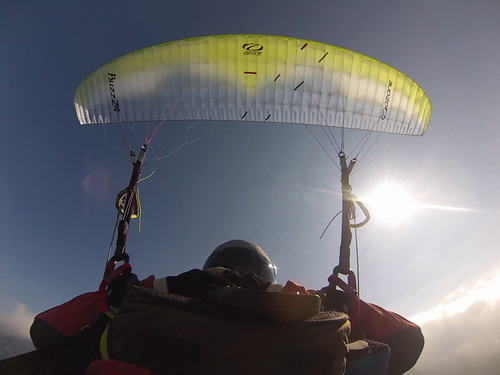BuzzZ 4 ML |
|||||||||||||||||||||||||||||||||||||||||||||||||||||||||||||||||||||||||||||||||||||||||||||||||||||||||||||||||||||||||


|
|||||||||||||||||||||||||||||||||||||||||||||||||||||||||||||||||||||||||||||||||||||||||||||||||||||||||||||||||||||||||
Instability rating |
|||||||||||||||||||||||||||||||||||||||||||||||||||||||||||||||||||||||||||||||||||||||||||||||||||||||||||||||||||||||||
|
|||||||||||||||||||||||||||||||||||||||||||||||||||||||||||||||||||||||||||||||||||||||||||||||||||||||||||||||||||||||||
Glider characteristics |
|||||||||||||||||||||||||||||||||||||||||||||||||||||||||||||||||||||||||||||||||||||||||||||||||||||||||||||||||||||||||
|
Launch preparations: easy
launch characteristics: balanced, climbs constantly, no guidance necessary, good feedback during inflation, little braking required, slows before zenith, control check simple, low takeoff speed
asymmetric collapse: canopy colllapses at high angle to leading edge, moderate dynamics, total course change 90-180°, (1), moderate course change rate, marked forward pitching 60-75°, (4), high height loss 40-49 m, (3), moderate sink velocity 15-19 m/s, (2), G-Force < 2,5 G, (1)
Frontal collapse: canopy collapses with high total collapse aera, high pitch backwards >60°, marked pitch forwards 45-60°, moderate dynamics, course change <90°, (2), variable recovery behaviour, at times immediate, at times delayed, automatic recovery, (3), usually symmetric recovery, delayed return to normal airspeed, short deep stall phase, high height loss 40-49 m, (3), moderate sink velocity 15-19 m/s, (2)
Spiral dives: moderate sink velocity increase, High G-Force 4,0-4,5 G, (3), Sink velocity after 720° <14 m/s, (1), High maximum sink velocity < 22 m/s, (3), sink velocity increase < 6 m/s on brake release, (2), Course change 360-540° after spiral exit, (3), high height loss during recovery 60-100 m, (3)
B-Stall: normal force required, moderate pitch backwards 15-30°, moderate pitch forwards 15-30°, stable sink phase, low deformation tendency, immediate return to normal airspeed, 8-10 m/s, height loss on recovery < 20 m
big ears: simple initiation, stable flight phase, immediate automatic recovery, Vsink unaccelerated 2,5-3 m/s, Vsink accelerated 3,5-4 m/s, Vunaccelerated 3-5 km/h less than trimspeed, Vaccelerated 3-5 km/h faster than trimspeed
Steering behaviour: balanced to agile, 70 cm brake travel range, Noticable brake pressure increase, Late stall point, easily identifiable |
|||||||||||||||||||||||||||||||||||||||||||||||||||||||||||||||||||||||||||||||||||||||||||||||||||||||||||||||||||||||||
Notes |
|||||||||||||||||||||||||||||||||||||||||||||||||||||||||||||||||||||||||||||||||||||||||||||||||||||||||||||||||||||||||
|
en: Launch preparations: Ozone's Buzz Z4 needs a little more care in sorting due to thinner lines, but it is positive that Ozone have not followed the trend of using unsheathed lines on this low end B glider. Launch characteristic: Ozone's Buzz Z4 has well balanced launch characteristics. The glider climbs evenly with good internal pressure after a small impulse and needs only minimal brake input to stabilise at the zenith but feedback via the risers is a little less and a little more control on the brakes is needed to stabilise at the zenith. The glider are easy to keep over the pilot with a little forwards movement and give plenty of time for a good control look before launching. Asymmetric Collapse: Ozone's Buzz Z4 (low-end LTF B classified) is a little more dynamic. Assymetric collapses at the maximum limit of the test field resulted in height losses of more than 40 meters. The Buzz Z4 never showed any tendencie to cravat after collapsing. Front collapses: For low end B gliders, behavior is happily much more benign, a good example for this is Ozone's Buzz Z4. After hard front collapses the glider recovers very rapidly, on occasion somewhat assymetrically. If less of the canopy is collapsed, then recovery takes a little longer and the wingtips tend to remain deflated for longer periods. Spiral Dive: Ozone's Buzz Z4 behaved quite moderately in the initiating phase but then accelerated rapidly in the spiral phase. To exit, the glider required almost 100 height meters, as it remained in the spiral at -20m/s for a complete turn before slowing an pitching up B-Stall: no problems with B-stalls, and this manoeuvre can be recommended for rapid descents if required. Big Ears: Very Easy. |
|||||||||||||||||||||||||||||||||||||||||||||||||||||||||||||||||||||||||||||||||||||||||||||||||||||||||||||||||||||||||
Rating |
|||||||||||||||||||||||||||||||||||||||||||||||||||||||||||||||||||||||||||||||||||||||||||||||||||||||||||||||||||||||||
|
Safety class 4 This class of paraglider reacts demandingly to one or more of the following manoeuvres: frontal collapse, asymmetric collapse or spiral dive.Demandingly means that the above manoeuvres result in marked dynamic reactions from the glider and/or large height losses. Advanced piloting skills which need to be regularly practised, together with good personal reaction times are required to safely fly this class of gliders. Basic recovery techniques for ending a manoeuvre are not sufficient to maintain control, reduce height loss to a minimum and prevent subsequent critical reactions. Pilots should be able to recognise the onset of the above manoeuvres and be able to prevent or minimise their effects through immediate and precise pilot inputs. Additional experience such as regular ground handling and SIV training is required to safely fly gliders of this class. Special training or pilot skills which exceed standard training may be required for the safe performance of emergency descent techniques. Gliders of this Safety Class are not suitable for beginners, irregular flyers or low-airtime pilots. |
|||||||||||||||||||||||||||||||||||||||||||||||||||||||||||||||||||||||||||||||||||||||||||||||||||||||||||||||||||||||||

